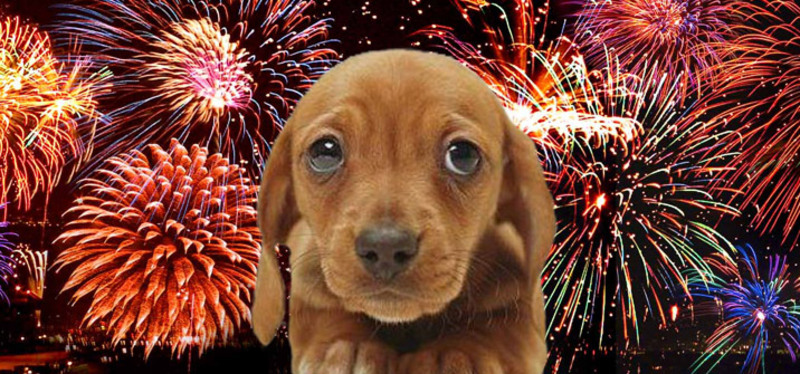Fireworks can terrify some pets. This shouldn’t be surprising: dogs have a far more sensitive sense of hearing than humans.
And they can’t understand that fireworks are a form of entertainment. The result of this double difference is that their impression of fireworks is very different to our own: they hear deafening, strange noises that they do not understand. They may wonder: “Could this be the beginning of the end of the world?” While some pets are not at all affected by fireworks, many are. As vets in practice, it’s common to have two or three people every day coming with queries about how to help their frightened pets.
Some dogs become hysterically upset. In the evenings, if they fireworks, even in the distance, they become agitated and distressed. They run from room to room, trying to get away from the sounds. They pant, whine and trembles, desperately upset by what’s going on. Their owners feel anxious, frustrated and helpless: what can they do to reassure their pet?
When owners of pets like this come to me for help, I suggest three ways to deal with the situation: first, physical changes at home, second, the use of calming drugs and products, and third, a long term plan for desensitisation.
Creating a fireworks-proof home
There are simple steps that all dog owners should take every year around the end of October, to make their home as firework-proofed as possible. Creating a safe, secure, sound-proofed, cosy pet den is the most important step. For example, a cupboard under the stairs or the central heating boiler room could be adapted to be your pet’s base at this time of year. A loud radio should be left on in this area, playing classical music all the time. Put the dog’s bed is in there, with plenty of bedding for her to hide under if she wants. Leave some old unwashed clothes of your own (such as sweatshirts) in their bed when so that your dog has a continual sense of their owner nearby, even when you are out of the house.
To help create a soothing atmosphere in the den, install a plug-in vapouriser. The classic one is the Adaptil vapouriser: instead of a pleasant smell, this emits a vapour containing “Dog Appeasing Pheromone” which is a synthetic form of a chemical that is naturally secreted by the mammary glands of a lactating bitch. The scent (undetectable to humans) has a reassuring, comforting effect on dogs, and helps to reduce anxiety in all situations. An alternative is to use a Pet Remedy vaporiser which emits a blend of essential oils including valerian, working alongside these natural relaxation pathways to help calm the nerves of anxious or stressed pets.
You also need to teach the dog’s owners not to give too much attention when their pet becomes agitated. If too much petting is given to a frightened dog, this can send a message that “it is good to be frightened”, and it can make the fearful behaviour more likely to occur. Instead, it’s better to try to carry on with normal activities around a frightened dog. The idea of is that pets should gradually learn that “it’s good to be calm”.
Simple changes of environment and human-dog interactions at home around fireworks time can often be enough to resolve minor fireworks fears.
Medication with calming drugs and other products
For dogs that show severe fearfulness at this time of year, the next level of intervention is to use anti-anxiety medication. There are a number of possible combinations of drugs, and it’s sometimes a case of trying various approaches before identifying the most effective calming products. Ideally, drugs that are licensed for dogs should be used, according to the cascade, but sometimes a combination of human drugs, used according to recommendations in drug formularies (such as BSAVA) can be tried. Most vet practices have their own favoured medication regimes for this purpose: if you are not sure, ask one of the experienced vets in your team.
A novel and different, additional approach is to get the dog to wear a novel item of clothing, called a Thundershirt. This is like a tightly fitting jacket, attached with Velcro strips, that applies constant pressure all over the dog’s body, according to the principles of Tellington Touch therapy. In one study, 82% of fearful dogs showed less anxious behaviour when wearing a Thundershirt. (The name is derived from a different fear that many dogs have: fear of thunder.)
Long term desensitisation
The ideal long term strategy for dogs that have severe fireworks phobias is to use sound therapy. You can download soundtracks of fireworks designed for this purpose. These are played with the volume turned down low, gradually increasing the volume as the dog gets used to the sounds. This type of sound therapy needs to be done far in advance of the fireworks season, which means starting early in the New Year, many months before the fireworks season. It’s difficult to be motivated to do this but it’s worth it for the long term.
Don’t forget guinea pigs and rabbits
Finally, don’t forget to remind your pets about smaller pets living in hutches in the garden: they can also be upset by fireworks noises, and every year, there are reports of rabbits and guinea pigs being found dead in their hutches the following morning. To protect them, bring them indoors when fireworks are expected.
Keep all pets indoors on big fireworks nights
Also, remember to remind owners to keep all pets securely shut inside on fireworks nights: dogs and cats are known to bolt away in panic, and there’s always a large number of stray animals that are found wandering the next day.
Fireworks do not need to mean “mass panic” to pets: a little planning and care can make all the difference to pets, and to the people who care for them.


